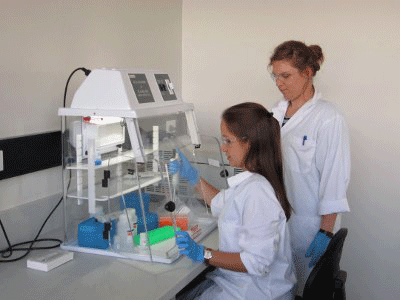
|
Published: 12 September 2011
New lab to identify pollution’s DNA ‘fingerprints’
CSIRO has opened a state-of-the-art environmental genomics laboratory at Lucas Heights that will support research into keeping our waterways healthy.

|
|
CSIRO staff using the new Lucas Heights facility. Credit: CSIRO
|
CSIRO Land and Water Chief, Dr Neil McKenzie, said scientists are applying environmental genomics, the study of DNA and RNA from biological organisms, to better understand the effects of pollutants on aquatic health.
'One measure of the health of a water body is the diversity of species it supports,’ said Dr McKenzie.
‘Where typically this involves a lengthy process of collecting and counting small organisms such as worms and small crabs under a microscope, CSIRO has developed a revolutionary genomic approach to identifying organisms in a water body.’
The new initiative involves extracting a mixture of the DNA from all the organisms in a specific site and comparing it to a DNA database comprising hundreds of thousands of different species.
Using this method, over 1000 different organisms can be identified, ranging in size from microscopic to the more visible species. Knowing the range of species allows scientists to determine whether and how a site is impacted by pollutants.
Dr McKenzie said opportunities for research in the new laboratory are numerous.
'We can examine the diets of individual organisms and better evaluate effects of contaminants in iconic areas such as the Barrier Reef, Kakadu National Park and the Murray River Basin.
‘Researchers can also better study the effects of complex mixtures of contaminants in major events such as oil spills.'
The new facility – part of CSIRO's Centre for Environmental Contaminants Research – will provide welcome support to advance environmental genomic research.
'Up until now, our researchers have been using laboratories at North Ryde and Canberra that had the appropriate instrumentation,’ added Dr McKenzie.
'Having our own facilities integrated with our expertise in environmental chemistry and ecotoxicology will accelerate the development and application of new genomic techniques to better protect our waterways.'
Source: CSIRO

